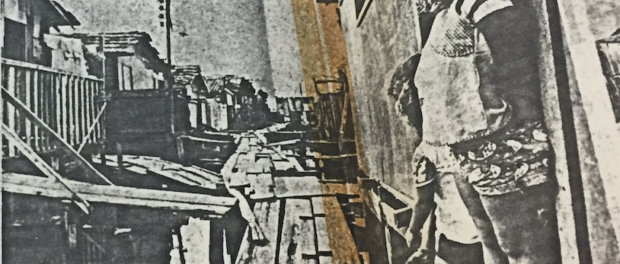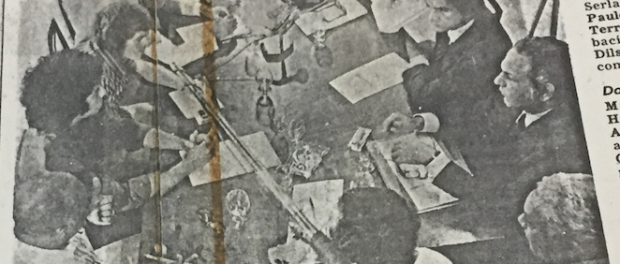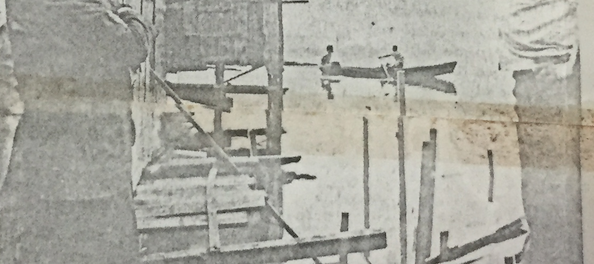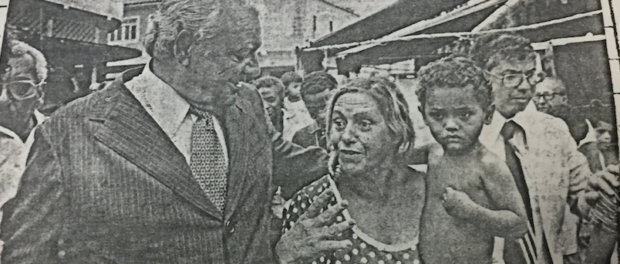
This is the first article in a three-part series on the history of the Projeto Rio urban renewal program in Maré, from 1979-1981.
On the afternoon of June 10, 1981, Brazil President João Baptista Figueiredo visited Morro do Timbau, one of the communities making up the Maré complex of favelas in Rio’s North Zone. Figueiredo, along with Rio de Janeiro Governor Antônio Chagas Freitas and Minister of the Interior Mário Andreazza, was in Maré to confer property title on over three hundred residents of the area. The proceedings, billed as the “first practical result” of Project Rio, a multilevel government urban infrastructure initiative, had a festive air, with an estimated crowd of five thousand people entertained by a band of naval fusiliers and Andreazza making a triumphal speech before the ceremony.
Just two years earlier, no one could have predicted that Project Rio would result in the celebration at Timbau. In June of 1979, the Ministry of the Interior announced a massive aterro, or land reclamation project, to be carried out by the federal Department of Sanitation Works (DNOS) that would create more than 2300 new hectares of land along the northwestern edge of Guanabara Bay. This new land, purportedly enough to house 1.2 million people—a quarter of the city of Rio’s population at the time—would provide space for increased transportation infrastructure, industry, and housing in the valuable and highly visible area sandwiched between downtown Rio, the international airport, and the federal university. The project, though, hinged on the eradication of Maré.
1979 was a year of change for the Brazilian government and its policy toward favelas, however. Figueiredo became the last president of the military dictatorship that year and began steering the country through a process of political opening or abertura. His administration passed a controversial amnesty law applying to both enemies and agents of the regime and legalized the creation of new political parties. The longstanding policy of removing favela residents to distant housing projects that had characterized the dictatorship’s approach to the “problem” of favelas also appeared to be changing in favor of on-site infrastructure upgrading. Project Rio would serve as the flagship of this new policy. In June of 1979, the project became part of a national program called Promorar, which scheduled favelas in seven cities throughout Brazil to receive Project Rio-like upgrades.
The purported benefits of Project Rio, however, had a dark side. Though not a full-scale eviction that would send Maré’s residents to housing projects in Rio’s outskirts, the project’s objective was to demolish the homes that Maré’s residents had built for themselves over decades and construct public housing projects, known as conjuntos habitacionais, in their place. In the absence of property title to the land they lived on, though, favela residents’ homes represented a lifetime of investment and were nothing like the squalid shacks government reports made them out to be. Government housing, even on-site, represented a significant step down for many of Maré’s residents.
The proposed aterro also ignored the work that thousands of the complex’s residents had been carrying out over decades to fill in the marshy land on the edge of Guanabara Bay themselves. Individual families would carry out a multi-step process to eventually build a brick house on a solid foundation, first constructing a stilt house known as a palafita over the water and then building up the land below the structure.
Although these palafitas represented a major achievement of construction on the part of Maré’s residents, federal and city authorities saw them as a blight to be removed. The dictatorship had invested in several large-scale public works projects in Rio, among them the Rio-Niterói bridge, the Aterro do Flamengo park just south of downtown, and the opening of Rio’s metro system in 1979. Even in the waning years of the military regime, the government did not want a large favela occupying Maré’s prominent location linking so many different areas of the city. The irregularity of favela architecture and especially the palafitas clashed with the modern image of Rio and Brazil that authorities wanted to project in 1979 and provided the motivation for the plan to replace Maré with orderly, government-built housing units.
Like the rest of Rio’s favelas, Maré had been subject to periods of hostility punctuating the government’s usual neglect throughout its history. Just a few years after its first settlements were made, a military regiment moved into the Morro do Timbau in 1947, creating repressive conditions for residents and demanding “occupation taxes” from residents in order to avoid eviction from their homes. In the community of Baixa do Sapateiro, another part of the complex, the 1950s saw the police demolishing residences and forcing occupants to restrict construction on their houses to the night hours for fear of attracting attention. These abuses led to the foundation of some of Rio’s first favela residents’ associations in Maré in the 1950s.
When Project Rio threatened the complex with eradication, Maré drew on this history of organizing to mobilize quickly against the government’s plans. Many of the members of the newly formed Committee for the Defense of the Favela of Maré (Codefam) were already leaders of the various residents’ associations in the favela. Codefam held a series of meetings with city, state, and municipal authorities, arguing that, instead of eradicating the favela, the government should give residents title to their land and encourage them to build their own houses, rather than hypocritically swooping in to demolish and rebuild the entire favela after ignoring it for decades. The press took advantage of the easing of censorship under abertura to help publicize opposition to Project Rio. In June 1979, for example, the O Globo newspaper hosted a high-profile roundtable meeting between Codefam and representatives from DNOS and several state agencies. Favela residents took advantage of the face-to-face meeting with government representatives to sharply criticize Project Rio, calling it a “siren’s song” that wanted nothing more than to destroy the favela and clear the area for new building projects.
As the weeks wore on, residents showed no sign of letting up the pressure on the authorities. Their hope was not completely out of the question, as favela residents who had lived at the whim of authority for decades knew how shifting political tides or significant difficulties could halt complicated and expensive removal plans in their tracks. Their strong response also reflects the fact that, in many respects, Project Rio was not an entirely new kind of threat to the favela. The community had had to solve its own infrastructure problems while deflecting government interference throughout its history. Just that year, in fact, in March 1979, residents organized to protest police brutality that was exacerbating poor health and sanitation conditions in the complex. In opposing Project Rio, Maré residents drew on the mobilization skills they had developed throughout a history of resistance and employed them in the more open political atmosphere of 1979.
Not all residents were equally committed to resistance, however. At the roundtable, one of the representatives of Codefam mentioned that some residents of Maré would choose to move from palafitas into conjuntos. These were families unable to afford the undertaking of converting those homes into more stable structures. At the roundtable, representatives from Codefam recognized that palafitas did not constitute ideal permanent housing conditions, which no doubt contributed to the government’s success in eradicating those portions of Maré. Still, on the main issue of preventing wholesale eradication, and securing basic respect and attention from the government, every member of Codefam stood firm.
The next month, in July, Codefam invited architect Oscar Niemeyer to Maré to appraise the urban quality of the complex. Niemeyer, Brazil’s most famous architect and the highly influential designer of Brasília, had only recently returned to the country thanks to Figueiredo’s amnesty law; his leftist beliefs had forced him to spend the dictatorship in exile in France. After being shown around different areas of the complex by community leaders, Niemeyer stated that he was highly impressed with the construction of the favela, though he declined to venture onto the unstable palafitas. The architect also called his visit to Maré part of a “movement of solidarity with the favelados”.
Niemeyer’s support for Maré residents pressed at the weakest point of the government’s justification for eradicating the complex. During the dictatorship, the regime had justified favela removal by citing environmental and architectural concerns. In advancing these narratives of removal, the government relied on paternalistic stereotypes of favelados as ignorant, uneducated people unfit to make any real claim to the land they lived on. Niemeyer’s expert praise of Maré undid this image and strengthened the favelados’ claims that the government’s so-called help was in fact just interference. Niemeyer was also not the only professional expressing doubts. Back in June, the Brazilian Institute of Architects (IAB) criticized the government’s plan in the press, terming it an “idea-Rio” instead of a project and pointing out that many of its objectives were badly defined. In October, the Institute released a report fully evaluating the project, which laid out in greater detail its criticism of the proposed aterro and accused the government of planning to speculate on the land.
The architects’ support, however, though valuable in its firmness and motivated by both politics and professional judgment, appears not to have been the main factor in preventing the eradication of the favela. Just a few days after Niemeyer’s visit to Maré and well before the IAB published its full criticism of the project, newspapers announced that, contrary to what was initially planned, Project Rio would not replace the entire complex with government housing. Instead, the article laid out what would become the new plan for the aterro: the palafitas would be converted into public housing, while the residents who had built their own houses would receive title to the land those houses stood on.
This change of plans represented an enormous victory for the thousands of favela residents who would be allowed to remain in their homes. The newspaper announcement did not specifically credit any group with influencing the government’s decision, though it did mention that Niemeyer would formulate a plan for the upgrading of the palafitas. This development suggests that their visit to Maré had not gone unnoticed and probably weighed heavily in the decision to halt eradication. DNOS may have found the courage, moreover, to insist on going through with converting the palafitas partly because a visibly nervous Niemeyer avoided them. Still, it seems unlikely that the government would dramatically alter its plans for a massive infrastructure project in the short period between Niemeyer’s visit and the announcement of the abandonment of eradication. The residents’ mobilization drove opposition to the plan, creating complications and weakening the authorities’ resolve until Niemeyer’s public comments delivered the coup de grâce to Project Rio in late July.
This is the first article in a three-part series on the history of the Projeto Rio urban renewal program in Maré, from 1979 to 1981.
Research for this piece was done through the archives housed in the Museu da Maré. Newspaper sources used were: Assessoria de Comunicação Social (1980), O Dia (1979-1981), O Fluminense (1979), O Globo (1979-1980), Isto É (1979), Jornal do Brasil (1979-1981), Jornal do Comércio (1981), Luta (1979-1981), Tribuna da Imprensa (1979), Ultima Hora (1979-1981).
Sources:
- Barbassa, Juliana. Dancing With the Devil in the City of God: Rio de Janeiro on the Brink. New York: Simon & Schuster, 2015.
- Freitas, Jânio de. “Imprensa e democracia.” Folha de S. Paulo (June 3, 2012).
- Guillermoprieto, Alma. Samba. New York: Vintage, 1990.
- Jacques, Paola Berenstein. “Cartografias da Maré.” In Maré: Vida Na Favela. Rio de Janeiro: Casa da Palavra, 2002.
- McCann, Bryan. Hard Times in the Marvelous City: From Dictatorship to Democracy in the Favelas of Rio de Janeiro. Durham and London: Duke University Press, 2014.
- Perlman, Janice E. Favela: Four Decades of Living on the Edge in Rio de Janeiro. New York: Oxford University Press, 2010.
- Silva, Cláudia Rose Ribeiro da. Maré: A Invenção de um Bairro. Master’s thesis. Fundação Getúlio Vargas: Centro de Pesquisa e Documentação de História Contemporânea do Brasil, 2006.
- Williams, Daryl; Chazkel, Amy; Knauss, Paulo, editors. The Rio de Janeiro Reader: History, Culture, Politics. Duke University Press, 2016.
Full Series: History of Urban Renewal ‘Project Rio’ in Maré
Part 1: A Siren’s Song
Part 2: Allies Join the Fight
Part 3: Government Breakdown




